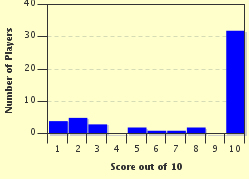Quiz Answer Key and Fun Facts
1. Large Magellanic Cloud, Tarantula Nebula, Supernova 1987A
2. The Jewel Box, the Coalsack, Acrux
3. Canopus, Mystic Mountain, Bullet Cluster
4. Lagoon Nebula, the Teapot, center of the Milky Way
5. Betelgeuse, Rigel, Horsehead Nebula
6. Aldebaran, the Pleiades, Crab Nebula
7. Deneb, Veil Nebula, X-1
8. Vega, Ring Nebula, Double Double
9. Thuban, Cat's Eye Nebula, Tadpole Galaxy
10. Alpheratz, Blue Snowball Nebula, closest spiral galaxy to the Milky Way
Source: Author
albert11
This quiz was reviewed by FunTrivia editor
rossian before going online.
Any errors found in FunTrivia content are routinely corrected through our feedback system.
